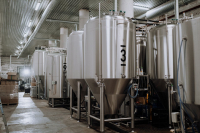Oval manways
Oval manways present a unique design that sits somewhere between the round and rectangular formats. The elliptical shape is particularly advantageous when there's a need for a wider access point without consuming as much vertical space. This makes them ideal for confined spaces or when vertical real estate is limited. Additionally, the curved design means they can withstand a moderate amount of internal pressure, making them suitable for a range of industrial applications.
Round (circular) manways
Round manways are one of the most common designs, recognized for their inherent strength due to the circular shape. The even distribution of stress around the circle ensures that they can handle a significant amount of pressure. This makes them particularly suited for high-pressure vessels and tanks. Additionally, the simplicity of the round design often translates to ease of sealing, ensuring that contents remain uncontaminated and that the vessel remains secure.
Rectangular manways
Rectangular manways provide a larger, more straightforward access point, making them suitable for tasks that require workers to enter the equipment or vessel. They are commonly found in low-pressure applications where the structural advantages of a round or oval manway aren't necessary. These manways often come with additional bracing or reinforcement to offset the stress concentrations at the corners, ensuring durability and long-lasting performance.
Pressure manways
As the name suggests, pressure manways are specifically designed to withstand internal or external pressure. They are predominantly used in vessels and tanks that operate under pressure, such as those in the chemical or petroleum industries. Their design, materials, and sealing mechanisms are meticulously chosen and crafted to ensure they remain secure, even under extreme pressure conditions. Regular inspections and maintenance are vital for these manways to ensure safety and efficiency.
Non-pressure manways
Non-pressure manways are primarily used in equipment or tanks that operate at atmospheric pressure. These manways are simpler in design compared to their pressure counterparts, as they don't have to withstand the stresses from pressurized contents. Typical applications include storage tanks, silos, or any vessel where rapid access is more critical than pressure containment. The emphasis for these manways is often on ease of access and simplicity of design.








